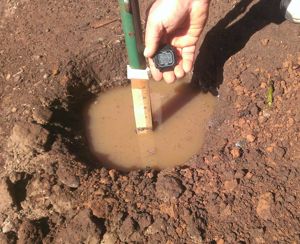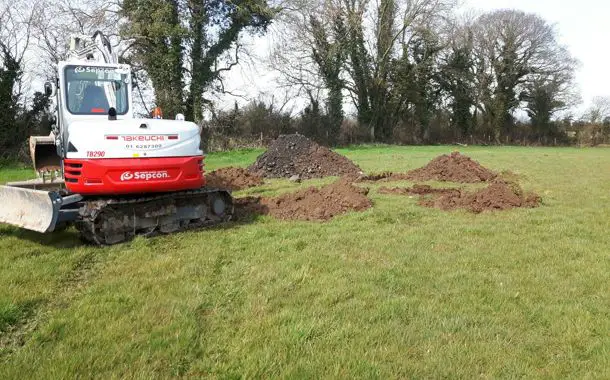How Much Does a Perc Test Cost?
Last Updated on April 19, 2024
Written by CPA Alec Pow | Content Reviewed by ![]() CFA Alexander Popinker
CFA Alexander Popinker
Before you install any type of septic system or other onsite wastewater treatment solution, conducting a percolation or “perc” test is vital to evaluate the soil’s ability to effectively absorb and filter liquid waste. But what specific factors go into determining the total cost of this critically important pre-development site assessment?
On average, budget anywhere from $300 on the very low end to over $1,000 or more on larger rural land tracts depending on variables like the property’s overall size, terrain complexity, local professional rates, and the actual scale and intricacy involved in the complete testing process.
This guide examines typical perc test pricing ranges, what influences costs, details on the soil analysis testing procedures, applicable regulatory standards and environmental laws governing testing, how measured absorption rates affect septic system design and site usage potential, and expert tips for managing and controlling perc test expenses through smart planning and budgeting. Let’s delve into the specifics of understanding perc test costs and maximizing value.
How Much Does a Perc Test Cost?
Typical costs to budget for professional perc testing services span the following averages:
- $300 to $600 for smaller residential suburban lots less than 1-2 acres.
- $600 to $800 for mini-farms and rural plots in the 2-5 acre range.
- $800 to $1,000+ for much larger undeveloped rural land parcels exceeding 5+ acres.
Building Advisor provides insights into the typical costs associated with Perc Testing, indicating that standard perc tests can range from $300 to $500 in lower-cost areas like the Midwest, and closer to $1,000 in high-cost areas like the West Coast or New England.
The cost may increase to $1,000 to $2,000 if a deep-hole test is required, including the cost of the excavator. However, a charge of $1,600 to certify the test may seem high, prompting the suggestion to explore other professionals for comparison.
Tennessee Land Development Services discusses the need for a Perc Test and soil testing, highlighting the importance of understanding the requirements for land development.
While specific prices are not mentioned on the website, they provide valuable information on the process and considerations involved in Perc Testing, especially in the context of land development and building projects.
Factors Influencing the Cost of a Perc Test
Several factors influence the precise pricing in terms of labor, equipment, and oversight needed for a particular property:
- Accessibility of the Site – Heavily wooded lots with difficult terrain that is arduous to traverse and dig test holes in increases the hands-on labor time and equipment transportation costs. Open-accessible sites are more affordable.
- Number and Scale of Test Holes – The more holes required to adequately measure absorption rates across larger or intricate site landscapes, the higher the professional fees involved. Minimum standards must be met.
- Regional Variations in Average Rates – Pricing varies across the country based on local professional rates and business overhead costs. Competitive options should be researched.
- Season and Weather Conditions – Completing tests when the ground is frozen or heavily saturated adds complexity that boosts costs due to potential scheduling delays and allowing adequate dry-out periods between test iterations.
Evaluating these key cost factors provides an essential perspective when budgeting and allows property owners to set realistic expectations. Despite the expense, perc testing delivers valuable data critical to properly designing functional, compliant septic systems based on accurate soil characteristics.
How Does a Standard Perc Test Work?
In overview, perc tests determine the soil’s absorption capacity and percolation rates by measuring how quickly water drains through a series of sample test holes dug across the site under controlled conditions. Typical perc test procedures include:
- Digging 6-12 inch diameter test holes approximately 1 foot deep in multiple representative locations distributed across the site where septic drainage field installation is slated. The number and locations match local health code requirements.
- Pre-soaking the test holes by maintaining standing water in them to saturate sidewalls and swell the soil for more consistent drainage readings when measurements begin.
- Pouring a standard volume of water into each saturated hole and precisely timing how quickly the water drains completely out of the hole.
- Repeating the drainage rate measurements under controlled volumes and timing conditions for consistency.
- Calculating absorption rates for each test hole based on the time required to drain the water volume. The slowest percolation rate among all holes becomes the benchmark used for properly sizing the septic system drainage capacity.
Only certified soil technicians and engineers follow the stringent testing protocols and provide detailed reports documenting the measured percolation rates essential for compliant septic system design and installation permitting.
Environmental Laws on Perc Testing
Because improperly designed and installed septic systems pose major groundwater contamination hazards if they fail, all U.S. states mandate compliance with strict perc test procedures and standards before issuing installation permits. Regulation specifics vary locally, but common requirements include:
- Following legally prescribed perc test methods matching state and county environmental health codes. No shortcuts allowed.
- Utilizing only state-certified soil technicians and engineers to conduct testing and documentation.
- Testing only under permissible weather conditions when the ground is not frozen, saturated or too dry.
- Minimum standards for perc test hole size, quantity, and spacing based on property acreage.
- Direct oversight by county health departments who approve testing procedures.
Adhering to these perc testing regulations ensures the resulting septic system design meets required safety and environmental standards. Always research specific local ordinances for mandatory expectations. Cutting corners risks major environmental consequences and invalid permits.
Measured Perc Rates
The professionally documented site-specific percolation rates measured during testing have significant impacts on the achievable septic system design parameters and overall property development potential:
- Rapid Perc Rates – Very fast drainage times indicating sandier, extremely permeable soils will necessitate larger septic drainage field absorption areas as the effluent liquid waste flows through the soil very quickly before filtration occurs.
- Slow Perc Rates – Extremely slow percolation rates signaling dense, less permeable clay-based soils severely limit allowable septic system size and capacity to avoid unsafe groundwater contamination from excess effluent backlogs.
- Failed Perc Rate Results – Sites with extremely poor percolation rates falling outside minimum absorption requirements necessitate expensive engineered drainage solutions or extending municipal sewer connections if available nearby. Septic systems may be infeasible.
The empirical perc rate data also greatly informs the viability of overall construction plans, development density, and real estate valuation potential of the land. Perc testing provides pivotal insights.
You might also like our articles about the cost of yard cleaning, house framing, or brick walkways.
Saving Money on Perc Test Costs
 For those looking to complete essential but expensive perc testing as cost-efficiently as possible, helpful strategies include:
For those looking to complete essential but expensive perc testing as cost-efficiently as possible, helpful strategies include:
- Comparing rates between multiple local qualified contractors to find the best value.
- Scheduling testing during traditionally drier seasons when possible to allow quicker turnaround between test iterations.
- Initially isolating testing to smaller sections of larger land tracts to determine suitability before assessing entire acreage.
- Having reports from one provider independently reviewed by another contractor to prevent potentially unnecessary resampling.
- Avoiding tendencies to overtest with excess holes beyond minimum regulatory requirements.
- Asking questions and challenging pricing if contractors recommend exceeding typical test hole quantities or other costs seem exorbitant.
With smart planning around timing, selective testing scope, budget-aligned contractor selection and IPMA-aligned oversight, perc testing can be completed cost-effectively while still providing the invaluable site condition insights necessary to support compliant, environmentally responsible septic system and property development.
Final Words
While perc test expenses ranging from $300 to over $1,000 per assessment on residential property may seem high at first glance, this professional soil analysis remains an absolutely essential pre-development investment for establishing viable onsite septic system drainage solutions that protect groundwater resources and comply with environmental regulations.
Taking proactive steps to secure accurate, standards-adherent results using qualified local contractors at reasonable pricing ensures your development vision for the land can become reality while preventing preventable pollution risks.
Consider perc testing a wise investment in your property’s maximum usage potential paired with responsible waste management practices.
Frequently Asked Questions
What is a perc test used for?
Perc tests directly measure the drainage and absorption capacity of the site’s soil. This data ensures septic systems can be properly engineered and designed to effectively handle estimated waste volumes based on the specific percolation rates. Proper perc testing prevents environmental hazards.
When did the use of perc tests become standardized in the U.S.?
Widespread adoption of professional perc testing began in the 1950s and 1960s as the considerable environmental impacts of poorly planned and designed septic systems were increasingly recognized. Perc testing provided data to size appropriate onsite systems.
Can perc test results change over time on a property?
Yes, major factors like extended heavy precipitation, periods of drought, extensive soil disturbances or grading, and shifting depth of the water table can alter absorption rates compared to those originally measured during past perc tests. Periodic retesting of high-use areas provides current data.


Leave a Reply
Want to join the discussion?Feel free to contribute!